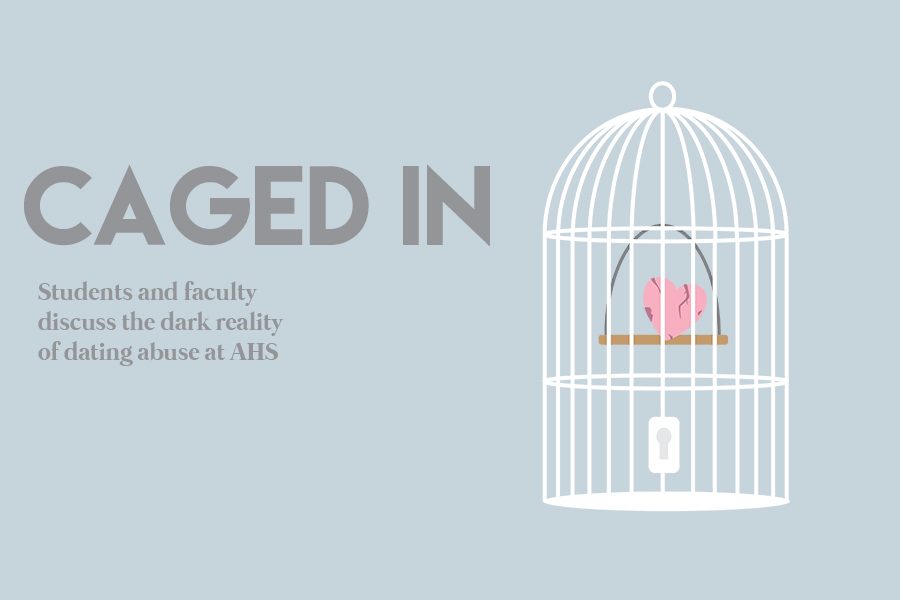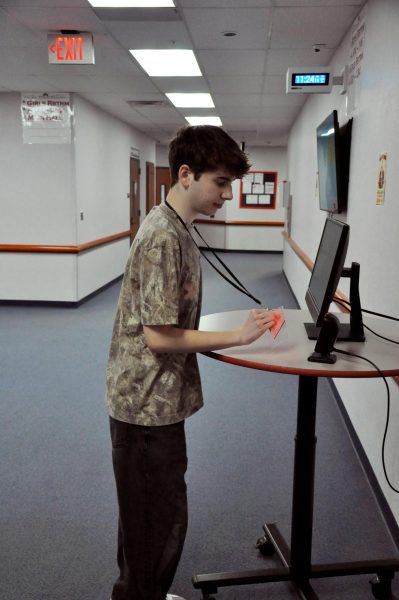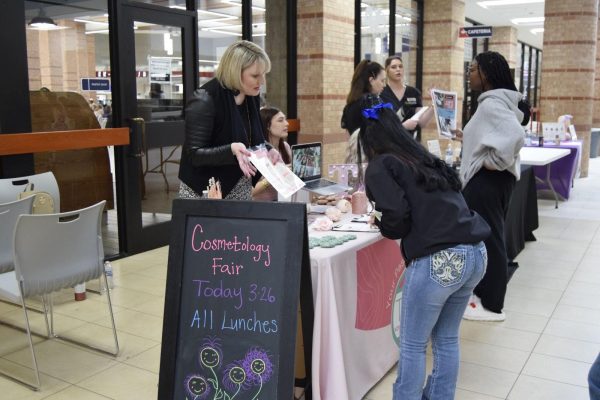Caged In
Students and faculty discuss the dark reality of dating abuse
During freshman year, senior Allison* didn’t have the luxury of going to bed. She wasn’t preoccupied staying up late to finish a riveting TV thriller. She wasn’t too fixated on Twitter to let her head sink into the pillows. Schoolwork wasn’t keeping her up to the early hours either. Not her own, anyway. The goal tonight was to make sure her boyfriend got his assignments done.
It wasn’t the first all-nighter she’d pulled taking care of him, and the role she played was familiar to her. Tears ran down her cheeks while she screamed. While she yelled. While she begged and begged for her boyfriend to finish his classwork. Because it was her job. It was her responsibility to keep him on track, and without her, he would only get worse.
It was better he stay afloat than her. It was worth his happiness even if she killed herself getting him there. It was for him. All for him.
“At the time, I didn’t notice [the warning signs],” Allison said. “People say hindsight is 20/20, you know?”
Pulling the curtain
According to Loveisrespect, 1.5 million high school students nationwide experience physical abuse from a dating partner every year, despite schools advocating against it. Allison says abusive partners easily brush off the preventions put in place.
“I got all the speeches in middle school about what to look out for, but so did he,” Allison said. “If he didn’t like something I did, he’d tell me not to do it. When I argued it he would say, ’Oh, so you’re telling me how to feel? You’re telling me what my feelings should be? That’s really abusive of you.’ I didn’t notice anything at the time because he convinced me the problems were on me.”
Allison walks the school halls brushing shoulders with students who have their own stories. A survey of 200 students at Allen High School concluded that 60 percent of students have known victims of dating abuse, and 18 percent of students have been victims themselves. Within that 18 percent, only 20 percent of those students reported the abuse.
Abuse, however, is indiscriminate, and students aren’t the only ones in danger. Physics teacher Tiffany Syfert recollects a troubled relationship in her past.
“I met the guy at a district church event,” Syfert said. “It was a situation where he put on a front to be what he believed I wanted him to be. It was sort of a wooing thing where he did whatever to make me happy, but once we were actually dating and I started to care for him, he became very controlling.”
Taking action
Crisis counselor Jennifer Atencio emphasizes the importance of a teenager’s security.
“Ultimately what we need to do is do our best to secure our students’ personal safety,” Atencio said. “If the student shares a class or lunch with their abuser, any kind of interaction with them, we try to adjust schedules. If there’s issues with transportation, say a bus, we can remove that student from the bus.”
Atencio also offers resources on and off campus for victims to help themselves, and for people to help victims they know.
“We have some free counseling available,” she said. “There’s also a women’s shelter in Plano called Hope’s Door. They do a lot of educational classes, and from time to time they’ll do group therapy sessions.”
For emergency situations, students should inform student resource officers or Atencio immediately. But for a dire crisis, some teachers, particularly Phoenix teacher Jayne Creelman, take it upon themselves to step in.
“There’s a certain ominous edge when something isn’t quite right,” Creelman said. “What I’ve seen is the female up against the wall and the boy very close, almost towering over her. The tone of voice is low and intimidating and frightening. We have to look [for] little clues.”
But more goes into abuse than intimidation. According to Bustle, there are seven primary signs of dating abuse including jealousy, a need for control and threats made against the victim. Control and threats characterized some of what Allison remembers, such as her ex-boyfriend endangering his life to keep her around.
“I guess he could only threaten to kill himself so many times before he actually tried to,” Allison said. “Honestly, he didn’t try though. He checked himself in. He would say ‘it was life changing, I’m so focused on my recovery now.’ And I’ve had a lot of friends go to [the behavioral center] and they all said it was awful. I think he just got attention for a week and was just being pretentious about a new thing.”
Syfert was caught in a similar situation, and points out that if she didn’t plan beforehand, it could’ve gotten much worse.
“I broke up with him on the phone, and ignored him for a little while, but he eventually got me to meet up with him at the chapel at our school,” Syfert said. “He pulled a knife and told me he was going to kill himself if I broke up with him. Luckily, I had the forethought to tell my roommate that if I wasn’t back in x amount of time, come find me, and she did. She found me in that situation, and I had to tell her to go get help.”
The staff tries to intervene when possible. Creelman recalls a few instances of when she stepped in, but also notes that students are good at keeping their secrets.
“It fills us with great dismay that many of you are distressed,” Creelman said. “In the class I teach, there is a lot of discussion and self-reflection that takes place, so sometimes I can pick up on things when the student is in a comfortable environment they feel safe in.”
Moving forward
Domestic abuse carries on beyond a single confrontation. Loveisrespect reports that half of teenagers who have been victims of dating violence will attempt suicide, compared to 12.5 percent of non-abused girls and 5.4 percent of non-abused boys. Syfert reflects on how her past relationships have affected her.
“I think that’s why it’s so hard for people on the outside to look at a relationship like that and understand why the victim stays for so long,” Syfert said. “It’s because you start to believe that he’s the only one that will care about you, he’s the only one who will accept the things I’ve done or what I am at this point. I started to lose parts of who I was, and I sometimes still have that battle. I didn’t really know who I was because I’d changed for so many different people to make them happy.”
Syfert says her loved ones understand the toll abuse can take on a person, even to this day.
“My husband now understands that there are certain things he can’t do,” Syfert said. “Like, he can’t move too quickly because I’ll react, or he can’t say certain things because I’ll cry.”
Despite her worries about coming forward, Allison notified her counselor and got herself help.
“I drew the line when he started calling my parents,” Allison said. “He would say things like ‘oh, Allison’s going on a drug binge, watch out.’ That’s when I decided to go to my counselor. When I got there, he walked out at the same time. He actually went to my counselor to lie to them about me going crazy.”
But in the end, the faculty supported Allison over her abuser.
“I went to the crisis counselor and cried and spilled my guts,” Allison said. “They bought my story a lot quicker than they bought his. They wrote [the restraining order] up and had us both sign it.”
If a student on campus sees any form of abuse happening, be it physical, emotional or otherwise, they are encouraged to report it. Atencio says speaking out is the first step toward getting real help.
“Students can report concerns on the tip411 program, which is anonymous,” Atencio said. “There’s no way for us, as a district, to track who posts. Email is usually the best way to reach me and set an appointment up. If it’s an emergency situation, go to the house office and have them try to locate me.”
The school provides support to victims in any way they can, even moving classes or sending abusers to the Dillard Center.
“If charges have been pressed, the abuser will likely be removed from campus, which could mean going to Dillard,” Atencio said. “We want to make sure the victim feels safe at school. If charges have been pressed and they meet certain criteria, the SROs and the administrators are notified.”
If Creelman could highlight anything to the student body, it’s that no student deserves to suffer in silence, and no student is alone.
“That’s what breaks my heart and keeps me worried about you all,” Creelman said. “You have to let us help you. You are precious. Love awaits in a mature, healthy, generous, respectful relationship. That’s what you deserve.”
*The name of the student interviewed for this story has been changed to protect their identity.

Senior Felix Kalvesmaki likes mangoes, true crime and the band Bleachers. He plans on going to NYU to study journalism and music production.

Senior Makayla Nerpel loves wombats, The Packers and Slytherin. She plans to study marketing at A&M Corpus Christi when she graduates.







